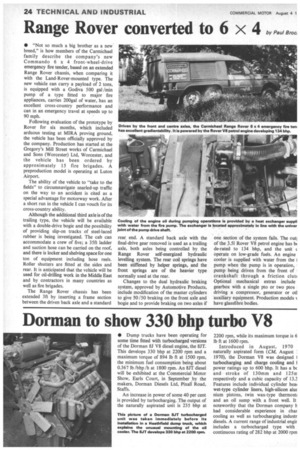Range Rover converted to 6 x 4
Page 26

If you've noticed an error in this article please click here to report it so we can fix it.
• "Not so much a big brother as a new' breed," is how members of the Carmichael family describe the company's new Commando 6 x 4 front-wheel-drive emergency fire tender, based on an extended Range Rover chassis, when comparing it with the Land-Rover-mounted type. The new vehicle can carry a payload of 2 tons, is equipped with a Godiva 500 gal /min pump of a type fitted to major fire appliances, carries 200gal of water, has an excellent cross-country performance and can in an emergency travel at speeds up to 90 mph.
Following evaluation of the prototype by Rover for six months, which included arduous testing at MIRA proving ground, the vehicle has been officially approved by the company. Production has started at the Gregory's Mill Street works of Carmichael and Sons (Worcester) Ltd, Worcester, and the vehicle has been ordered by approximately 15 fire brigades. A preproduction model is operating at Luton Airport.
The ability of the vehicle to "take to the fields" to circumnavigate snarled-up traffic on the way to an accident is cited as a special advantage for motorway work. After a short run in the vehicle I can vouch for its cross-country ability.
Although the additional third axle is of the trailing type, the vehicle will be available with a double-drive bogie and the possibility of providing slip-on tracks of steel-laced rubber is being investigated. The cab can accommodate a crew of five; a 35ft ladder and suction hose can be carried on the roof, and there is locker and shelving space for one ton of equipment including hose reels. Roller shutters are fitted at the sides and rear. It is anticipated that the vehicle will be used for oil-drilling work in the Middle East and by contractors in many countries as well as fire brigades.
The Range Rover chassis has been extended 3ft by inserting a frame section between the driven back axle and a standard rear end. A standard back axle with the final-drive gear removed is used as a trailing axle, both axles being controlled by the Range Rover self-energized hydraulic levelling system. The rear coil springs have been stiffened by helper springs, and the front springs are of the heavier type normally used at the rear.
Changes to the dual hydraulic braking system, approved by Automotive Products, include modification of the master cylinders to give 50/50 braking on the front axle and bogie and to provide braking on two axles if
one section of the system fails. The out] of the 3.51 Rover V8 petrol engine has IN de-rated to 134 bhp, and the unit c operate on low-grade fuels. An engine cooler is supplied with water from the pump when the pump is in operation, pump being driven from the front of crankshaft through a friction clutc Optional mechanical extras include gearbox with a single pto or two ptos driving a compressor, generator or otl auxiliary equipment. Production models N have glassfibre bodies.








































































































